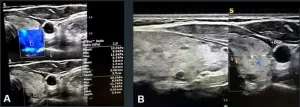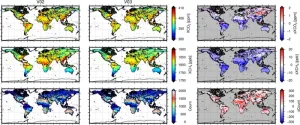(Press-News.org) PULLMAN, Wash. -- A viable formula for a carbon-negative, environmentally friendly concrete that is nearly as strong as regular concrete has been developed at Washington State University.
In a proof-of-concept work, the researchers infused regular cement with environmentally friendly biochar, a type of charcoal made from organic waste, that had been strengthened beforehand with concrete wastewater. The biochar was able to suck up to 23% of its weight in carbon dioxide from the air while still reaching a strength comparable to ordinary cement.
The research could significantly reduce carbon emissions of the concrete industry, which is one of the most energy- and carbon-intensive of all manufacturing industries. The work, led by doctoral student Zhipeng Li, is reported in the journal, Materials Letters.
“We’re very excited that this will contribute to the mission of zero-carbon built environment,” said Xianming Shi, professor in the WSU Department of Civil and Environmental Engineering and the corresponding author on the paper.
More than 4 billion tons of concrete are produced every year globally. Making ordinary cement requires high temperature and combustion of fuels. The limestone used in its production also goes through decomposition which produces carbon dioxide, so that cement production is thought to be responsible for about 8% of total carbon emissions by human activities worldwide.
Researchers have tried adding biochar as a substitute in cement to make it more environmentally friendly and reduce its carbon footprint, but adding even 3% of biochar dramatically reduced the strength of the concrete. After treating biochar in the concrete washout wastewater, the WSU researchers were able to add up to 30% biochar to their cement mixture. The paste made of the biochar-amended cement was able to reach a compressive strength after 28 days comparable to that of ordinary cement of about 4,000 pounds per square inch.
“We’re committed to finding novel ways to divert waste streams to beneficial uses in concrete; once we identify those waste streams, the next step is to see how we can wave the magic wand of chemistry and turn them into a resource,” said Shi. “The trick is really in the interfacial engineering – how you engineer the interfaces in the concrete.”
The caustic concrete washout water is a sometimes problematic waste material from concrete production. The wastewater is very alkaline but also serves as a valuable source of calcium, said Shi. The researchers used the calcium to induce the formation of calcite, which benefits the biochar and eventually the concrete incorporating the biochar.
“Most other researchers were only able to add up to 3% biochar to replace cement, but we’re demonstrating the use of much higher dosages of biochar because we’ve figured out how to engineer the surface of the biochar,” he said.
The synergy between the highly alkaline wastewater that contains a lot of calcium and the highly porous biochar meant that calcium carbonate precipitated onto or into the biochar, strengthening it and allowing for the capture of carbon dioxide from the air. A concrete made of the material would be expected to continue sequestering carbon dioxide for the lifetime of the concrete, typically 30 years in pavement or 75 years in a bridge.
In order to commercialize this technology, the researchers have been working with the Office of Commercialization to protect the intellectual property and have filed a provisional patent application on their carbon-negative concrete work. They recently received a seed grant from the Washington Research Foundation to produce more data for a variety of use cases. They are also actively seeking industry partners from the building and construction sector to scale up production for field demonstrations and licensing this WSU technology.
END
Researchers develop carbon-negative concrete
2023-04-18
ELSE PRESS RELEASES FROM THIS DATE:
Novel score predicts heart failure improvement after atrial fibrillation ablation
2023-04-18
Barcelona, Spain – 18 April 2023: A score based on four readily available clinical and imaging parameters identifies the heart failure patients who benefit most from atrial fibrillation ablation, according to late breaking science presented at EHRA 2023, a scientific congress of the European Society of Cardiology (ESC).1
Atrial fibrillation and heart failure often coexist.2 It is estimated that approximately 30% of patients with heart failure will develop atrial fibrillation and patients with atrial fibrillation have a five-fold increased risk of developing heart failure.3 Each condition aggravates the prognosis of the other. Atrial fibrillation patients who develop ...
IOP Publishing expands its open access environmental portfolio with the launch of Environmental Research: Energy
2023-04-18
Responding to the increasing demand for sustainable energy research, IOP Publishing is launching a new open access (OA) environmental research journal. Environmental Research: Energy (EREN) will openly publish the latest findings around clean and sustainable energy for all. Aligned with a number of the UN’s Sustainable Development Goals (SDGs), the journal launch comes at a time when research output around renewable energy and sustainability has seen a 600% increase compared to ten years ago.
Environmental Research: Energy is the latest addition to IOP Publishing's expanding Environmental Research ...
Novel ablation strategy improves freedom from arrhythmias in atrial fibrillation patients
2023-04-18
Barcelona, Spain – 18 April 2023: An innovative three-step ablation approach including ethanol infusion of the vein of Marshall improves freedom from arrhythmias in patients with persistent atrial fibrillation compared to pulmonary vein isolation (PVI) alone, according to late breaking science presented at EHRA 2023, a scientific congress of the European Society of Cardiology (ESC).1 Preliminary results at 10 months are presented, with follow up ongoing until 12 months.
The cornerstone of catheter ablation of atrial fibrillation is complete isolation of the pulmonary veins.2 However, only 50–60% of patients remain in sinus rhythm at two years.3 Numerous ...
Patients with atrial fibrillation have an average of five additional medical conditions
2023-04-18
Barcelona, Spain – 18 April 2023: A novel software tool set to improve the management of elderly atrial fibrillation patients with multiple conditions is being designed by the EU-funded and ESC-coordinated EHRA-PATHS consortium. The latest updates on this clinical innovation will be presented at EHRA 2023, a scientific congress of the European Society of Cardiology (ESC).1
Scientific coordinator Professor Hein Heidbuchel said: “EHRA-PATHS is developing a standardised approach to ensure that patients with atrial fibrillation receive evidenced-based therapies for the comorbidities that underlie or complicate their heart rhythm disorder.”
Atrial ...
ARRS Annual Meeting: vascularity, elastography in suspicious TIRADS scores differentiate malignant thyroid nodules
2023-04-18
Honolulu, HI | April 18, 2023—Findings from an award-winning Scientific Online Poster presented during the 2023 ARRS Annual Meeting on the island of Oahu determined that assessing the vascularity and elastography in suspect TIRADS categories can efficiently diagnose malignancy of thyroid nodules.
Acknowledging that sonographic TIRADS scoring remains the first method of imaging assessment for diagnosing malignant thyroid nodules, “we assessed the added value of shear-wave elastography (SWE) to classic TIRADS assessment,” said Leila Aghaghazvini, MD, from the department of radiology at Shariati Hospital and Iran’s University ...
American Roentgen Ray Society's Roentgen Fund presents 2023 Honorary Lecture, “Advanced High-Resolution CT,” in memory of W. Richard Webb
2023-04-18
Honolulu, HI | April 18, 2023—The American Roentgen Ray Society (ARRS) is pleased to announce that The Roentgen Fund® 2023 Honorary Lecture, “Advanced High-Resolution CT (HRCT),” will be dedicated to W. Richard “Rick” Webb, MD—the late University of California, San Francisco (UCSF) radiologist who transformed the practice of thoracic imaging.
Exploring multiple conditions diagnosed via HRCT, as well as the radiologist’s role on today’s multidisciplinary teams, “Advanced HRCT” will take place on Tuesday, April 18, 2023, 1:00–2:20 PM local time, during the 2023 ARRS Annual Meeting in Honolulu, HI.
A high-profile presentation ...
Update on the analysis method to estimate the greenhouse gas concentrations from GOSAT
2023-04-18
1. Background and objectives
The Greenhouse gases Observing SATellite (GOSAT) that is the joint mission of the Ministry of Environment, the National Institute for Environmental Studies (NIES), and the Japan Aerospace Exploration Agency has observed almost continuously since its launch and is currently in operation.
Thermal And Near-infrared Sensor for carbon Observation – Fourier Transform Spectrometer (TANSO-FTS) onboard GOSAT observes the shortwave infrared (SWIR) spectra(*1). The carbon dioxide (CO2) and methane (CH4) concentrations can be estimated by ...
Healthcare epidemiologists and infectious diseases experts review changing context for masking in healthcare settings
2023-04-18
The time has come and gone for universal masking in healthcare settings, according to healthcare epidemiologists and infectious diseases experts from healthcare systems throughout Boston and beyond. In a commentary published in Annals of Internal Medicine and co-authored by experts from Mass General Brigham, Beth Israel Lahey Health, Tufts Medicine, the VA Healthcare System Boston, and other healthcare systems across the country, the authors describe the changing context and conditions of the pandemic and outline why universal masking should no longer be required in healthcare settings.
“While critically important in the earlier ...
Cardiac arrest in hospital: survival a matter of resources
2023-04-18
Hospital inpatients have better prospects of surviving a cardiac arrest in large hospitals and well-resourced wards, and daytime cardiac arrests are also associated with better chances of survival, a University of Gothenburg thesis shows.
Cardiac arrest means that the heart stops pumping blood. Within seconds, unconsciousness occurs; within minutes, brain cells start dying, causing irreparable damage.
The key to enhancing the patients’ chances of survival is restoring the circulation of oxygenated blood in the body. ...
Early study - faecal transplant to help slow early-stage motor neuron disease progression
2023-04-18
A randomised clinical trial is looking at whether faecal microbiota transplantation (FMT) from healthy donors into adults with early-stage amyotrophic lateral sclerosis (ALS – one of the most common forms of motor neurone disease) can modulate the immune reaction during inflammation responses that characterise disease progression, and aims to investigate the relationship between specific gut bacteria and their action on immune system cells.
The preliminary findings by Dr Alessandra Guarnaccia from Columbus-Gemelli University Hospital IRCCS, Rome, Italy and ...




